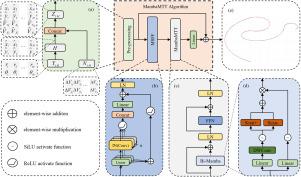MambaMTT: A deep learning method based on mamba structure for maneuvering target tracking
IF 3.6
2区 工程技术
Q2 ENGINEERING, ELECTRICAL & ELECTRONIC
引用次数: 0
Abstract
The research area of maneuvering target-tracking in radar system has emerged as a critical and valuable research frontier. The diverse and unpredictable movements of maneuvering targets make it hard to estimate their state accurately. This challenge often makes previous methods unreliable in dealing with maneuvering targets, especially the highly maneuvering ones. Although Transformer-based models possess global modeling capabilities, they encounter computational challenges when applied to long trajectory sequences due to their inherent computational complexity. To address the problem of highly maneuvering targets tracking, this paper proposes a Mamba-based maneuvering target tracking algorithm, termed as MambaMTT. MambaMTT is specifically designed to model trajectory change patterns by focusing on local and global feature correlation information of the trajectory sequence, facilitating the effective processing of highly maneuvering targets. Meanwhile, we introduce a multi-scale feature fusion module to capture spatial and temporal correlations at different scales within the trajectory sequence. With this module, the MambaMTT network is able to capture local and global trajectory features more efficiently, improving the model’s adaptability and accuracy for complex maneuvering targets. Experimental results show that the proposed MambaMTT algorithm exhibits higher tracking efficiency and accuracy in various maneuvering target tracking, and it also has better generalization ability on data beyond the training range.

MambaMTT:一种基于曼巴结构的机动目标跟踪深度学习方法
雷达系统中机动目标跟踪已成为一个重要而有价值的研究前沿。机动目标运动的多样性和不可预测性使其状态难以准确估计。这种挑战往往使以往的方法在处理机动目标,特别是高机动目标时变得不可靠。尽管基于transformer的模型具有全局建模能力,但由于其固有的计算复杂性,它们在应用于长轨迹序列时遇到计算挑战。为了解决高机动目标跟踪问题,提出了一种基于MambaMTT的机动目标跟踪算法。MambaMTT是专门针对弹道变化模式建模而设计的,通过关注弹道序列的局部和全局特征相关信息,促进对高机动目标的有效处理。同时,我们引入了多尺度特征融合模块来捕获轨迹序列中不同尺度的时空相关性。有了这个模块,MambaMTT网络能够更有效地捕获局部和全局轨迹特征,提高模型对复杂机动目标的适应性和准确性。实验结果表明,所提出的MambaMTT算法在各种机动目标跟踪中具有较高的跟踪效率和精度,并且对训练范围以外的数据具有较好的泛化能力。
本文章由计算机程序翻译,如有差异,请以英文原文为准。
求助全文
约1分钟内获得全文
求助全文
来源期刊

Signal Processing
工程技术-工程:电子与电气
CiteScore
9.20
自引率
9.10%
发文量
309
审稿时长
41 days
期刊介绍:
Signal Processing incorporates all aspects of the theory and practice of signal processing. It features original research work, tutorial and review articles, and accounts of practical developments. It is intended for a rapid dissemination of knowledge and experience to engineers and scientists working in the research, development or practical application of signal processing.
Subject areas covered by the journal include: Signal Theory; Stochastic Processes; Detection and Estimation; Spectral Analysis; Filtering; Signal Processing Systems; Software Developments; Image Processing; Pattern Recognition; Optical Signal Processing; Digital Signal Processing; Multi-dimensional Signal Processing; Communication Signal Processing; Biomedical Signal Processing; Geophysical and Astrophysical Signal Processing; Earth Resources Signal Processing; Acoustic and Vibration Signal Processing; Data Processing; Remote Sensing; Signal Processing Technology; Radar Signal Processing; Sonar Signal Processing; Industrial Applications; New Applications.
 求助内容:
求助内容: 应助结果提醒方式:
应助结果提醒方式:


